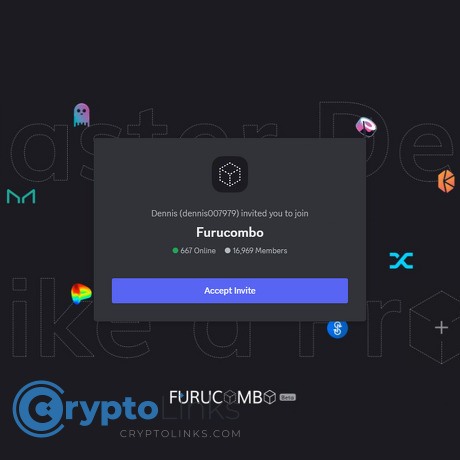Furucombo Review
Furucombo
discordapp.com
Furucombo Review Guide: Everything You Need To Know + FAQ
Ever wanted to swap, lend, borrow, and rebalance across DeFi without juggling five tabs and six transactions? That’s exactly why people use Furucombo. It lets you stack protocol actions like Lego cubes and fire them off in a single, clean transaction—so your plan runs end‑to‑end without timing hiccups.
In this review, I’ll show how Furucombo helps you bundle complex moves into one flow, where it shines, what can bite you if you’re not careful, and how I approach it safely. If you’re chasing better rates, cutting gas, or just want fewer clicks with less risk of messing up a sequence, you’ll find a ton of value here.
Why DeFi feels harder than it should
DeFi is powerful, but the workflow can be clunky:
- Too many steps: swap here, deposit there, borrow elsewhere, pay fees at every stop.
- Timing risk: markets move while you’re approving and clicking through transactions.
- Approval sprawl: every new protocol asks for token approvals—each one adds surface area for mistakes.
- Human error: one wrong amount or token and the whole plan falls apart.
- Gas overhead: multiple transactions can cost more than you planned, especially on busy networks.
Real talk: I’ve watched people get rekt not because their idea was bad, but because step 3 didn’t confirm before price moved, or a missing approval killed the final leg of a refinance.
The promise: one plan, one click, fewer headaches
Furucombo takes those multi‑step plays—swap, deposit, borrow, repay, withdraw—and lets you chain them into a single, atomic transaction. You design the flow visually with cubes, simulate it, then execute once. That means:
- Fewer transactions: often cheaper, always cleaner.
- Lower timing risk: your steps run back‑to‑back in one go.
- Tighter control: set slippage and see expected outputs before you send.
- Safer workflow: less chance of missing a step or getting stuck mid‑refinance.
Helpful context: Batch‑style execution can reduce failure points and MEV exposure compared to clicking through a chain of separate transactions. It doesn’t eliminate risk, but it often cuts it meaningfully when used well.
What you’ll learn here
- What Furucombo is and how its visual “cubes” and “combos” come together
- Practical examples: refinancing debt, basket swaps, moving vaults for better APY
- How to build, simulate, approve, and execute with a clear checklist
- Fees and gas basics, common errors, and the fixes that actually work
- Safety notes: permissions, proxy execution, and what’s public/verified
- A fast FAQ with the exact answers people keep asking
Here’s a taste of what this can handle in one transaction:
- Refinance a loan: use a flash loan to repay Protocol A, move collateral, and open a lower‑APR position on Protocol B—no risky “gap” between steps.
- Portfolio rebalance: split one asset into a basket of tokens across multiple DEXs with strict min‑receive settings.
- Vault migration: withdraw from a lower APY vault, swap if needed, and deposit into a higher APY vault—without juggling approvals in between.
Quick note on risk and responsibility
- DeFi is risky. Strategies can fail, markets move, contracts can have bugs.
- Simulate everything. If the preview looks off, it probably is—tweak or reduce the steps.
- Start small. Prove the flow with tiny amounts before you scale.
- Control approvals. Approve only what’s needed and revoke extras after.
If you’ve ever thought, “I wish I could just build my plan once and send it,” you’re in the right place. Next up, I’ll show you—in plain English—what Furucombo actually is under the hood and why “one transaction” matters more than most folks realize. Ready to see how the cubes, combos, and proxy execution fit together?
What Furucombo is and how it works (in plain English)
Think of Furucombo as a visual remote control for DeFi. Instead of clicking through five different apps and hoping nothing changes mid-way, you stack actions into a single, smart transaction that runs from start to finish. If it succeeds, every step is executed. If one step can’t happen, none of them do—and your funds snap back to where they started (you still pay gas, of course). That’s the “all or nothing” comfort I want when the stakes are high.
“Complexity compounds risk. Compress it into one intention.”
I like tools that make me slower to panic and faster to finish. Furucombo sits in that sweet spot: fewer clicks, fewer timing mistakes, and far more control over what actually happens to your money.
Cubes, combos, and the proxy contract
Furucombo uses a simple building block model:
- Cubes: A cube is one action in a protocol (e.g., swap on Uniswap, deposit collateral on Aave, borrow from Compound, deposit to a vault).
- Combo: Your sequence of cubes—executed in order, inside one transaction.
- Proxy contract: A verified smart contract that temporarily executes the steps on your behalf and returns funds back to your wallet when it’s done.
Here’s what that looks like in real life:
- Swap WETH → DAI on Uniswap
- Deposit DAI into Aave as collateral
- Borrow USDC from Aave
- Optionally repay something elsewhere or move into a vault
All of that runs as one, atomic transaction. If any leg fails (slippage too tight, price moves, etc.), the whole thing reverts—so you don’t get stuck halfway with collateral in limbo.
Where your funds go during execution
Furucombo doesn’t hold your funds. The proxy contract executes your planned steps during the transaction, then sends assets back to your wallet (or to the target protocol you specified, like leaving collateral on Aave). It’s non-custodial by design. You can view the proxy’s code on the chain explorer (it’s verified), which is a baseline check I expect from any serious DeFi tool.
Supported wallets, networks, and protocols
You connect a standard web3 wallet (MetaMask and other EVM wallets work). Furucombo supports popular EVM networks and well‑known protocols. Availability changes as DeFi evolves, so always confirm inside the app before you plan anything big. Commonly seen:
- Wallets: MetaMask, WalletConnect-compatible wallets, hardware wallets via those connectors
- Networks: Ethereum, Polygon, Arbitrum, Optimism, Avalanche (check current support)
- Protocols: Uniswap, Aave, Compound, and vault platforms (again, check what’s live before building)
Why “one transaction” matters
- Less timing risk: Markets move fast. Bundling steps means there’s no awkward pause between “deposit” and “borrow” or between “withdraw” and “swap.” That narrower time window reduces the chance your plan breaks mid‑way. As the Ethereum docs on MEV explain, reordering and frontrunning are real risks in the mempool; keeping actions inside one atomic transaction shortens the exposure window. See: ethereum.org on MEV.
- Cleaner approvals: You control approvals within the flow, instead of spreading them across several apps over several days. Fewer approvals, fewer lingering permissions to worry about later.
- Potential gas savings: Multiple separate transactions each pay the base cost (21,000 gas on Ethereum, per the protocol rules). One combo pays that once, then executes internal calls. You still pay for every action, but you avoid repeating base overheads and extra UI misfires. It’s not guaranteed cheaper every time, but for multi‑step plans it often helps. Reference: Ethereum transaction basics.
- Better control of slippage: You set min‑receive amounts and guardrails once, and the whole plan respects them. If your terms aren’t met, the transaction reverts.
Simple mental model: atomic = all or nothing
Atomicity just means your combo either completes entirely or doesn’t happen at all. No stranded debt, no half‑moved collateral. That peace of mind is the main reason I reach for Furucombo when I’m refinancing or doing bigger rebalances.
What Furucombo is not
- Not a “profit button”: It won’t invent a strategy. It executes the one you design.
- Not a vault or fund: There’s no pooled capital or passive yield. It’s a builder, not a manager.
- Not a fix for a bad plan: If the logic is off, a perfect execution just gets you the wrong result faster. Garbage in, garbage out.
Real‑world example to make it click
Say I want to move from volatile exposure to a safer stablecoin stack without juggling apps:
- Swap a slice of ETH to USDC
- Repay a borrow on Compound using that USDC
- Withdraw the freed‑up collateral (DAI)
- Swap DAI → USDC and send to a stablecoin vault
That’s the kind of “one intention, one transaction” flow Furucombo is built for. Fewer loose ends, fewer anxious refreshes.
Curious what this looks like on‑screen and how to keep it safe on your first run? I’m about to map the exact clicks, from connect to simulate to execute—want the step‑by‑step playbook?
Getting started: build your first combo safely
I know the feeling: you’ve mapped out a clever DeFi move in your head, but you’re worried about approvals, slippage, and gas blunders. Here’s the exact flow I use to turn that idea into a clean, one‑shot transaction that doesn’t keep me up at night.
“Slow is smooth, and smooth is fast.” In DeFi, that means simulate, sanity‑check, then send.
Connect wallet, pick your network, and start a blank combo
Open the Furucombo app, connect your wallet, pick your network, and hit the “+” to add your first cube. Simple start, but don’t rush past this screen.
- Confirm you’re on the right network (e.g., Ethereum, Arbitrum). A surprising number of mistakes start here.
- Check your balance of the token you’ll use first in the sequence. If you need to bridge or swap beforehand, handle that first.
Add cubes: swaps, deposits, borrows, repayments
Now build your flow with the cubes you need—swap, deposit, borrow, repay, withdraw. Furucombo handles the order atomically when you execute.
Starter example (low‑stress, useful in real life):
- Swap: ETH → USDC on a DEX cube (pick Uniswap or your preferred DEX)
- Deposit: USDC into a lending market (e.g., Aave supply cube)
- Borrow: Borrow DAI against your USDC collateral
Why this combo? It’s a clean way to move into a stablecoin collateral position and unlock a stable borrow in one transaction. No juggling multiple txs or timing risk between steps.
Refinement ideas:
- Already sitting on USDC? Skip the swap cube.
- Want to unwind later? You’ll use the reverse flow: repay → withdraw → swap.
Simulate before you send
Simulation is where “good plan” turns into “go.” I never skip it.
- Check expected outputs: Are the final token amounts what you expect?
- Slippage: For liquid pairs (ETH/USDC), I often set 0.2%–0.5%. For thinner liquidity, 1.0%+ might be safer. If you set it too tight, expect more failures.
- Gas estimate: Does it look reasonable relative to network conditions? If it spikes wildly, a cube might be misconfigured.
- Pathing: Ensure the swap route makes sense. If price impact is high, reduce size or split steps.
Why this matters: Research from MEV teams like Flashbots and mempool watchers like Blocknative has shown that price movements and reordering are common under load. A good simulation and sensible slippage protect you from nasty surprises.
Approvals the smart way
Approvals are where many users get too casual. Don’t.
- Approve only what you need if the interface allows amount‑limited approvals. Unlimited approvals are convenient but expand risk.
- Use a permissions check tool after you’re done. I rotate between revoke.cash and Etherscan’s Token Approval Checker to prune access I no longer need.
- Plan approvals ahead of time if you’re moving size. Sometimes I do a separate, tiny approval first to ensure the spender is correct.
Execution checklist
Right before I hit send, I run this quick mental list:
- Network and tokens: Correct chain, correct token contracts (always eyeball the token addresses).
- Min received/slippage: Aligned with volatility and your risk tolerance.
- Health factor (if borrowing): Keep a comfortable buffer above liquidations—especially in choppy markets.
- Gas settings: If time‑sensitive, set a higher priority fee. If not urgent, standard is fine.
- Nonce control (advanced): If you’ve got pending txs, make sure nonce ordering won’t block you.
Post‑execution sanity check
Once the combo lands, I always verify the end state—never assume. A 60‑second check can save hours later.
- Wallet balances: Did your tokens update as expected?
- Protocol positions: Open Aave/Compound and confirm deposits, borrows, and health factor.
- Cross‑view tools: A quick glance in DeBank or Zapper helps you spot anything off.
- Record the tx link: I keep a simple note with the strategy, tokens, and tx URL. It helps with tracking PnL and taxes later.
- Tidy approvals: If you granted any broad approvals, prune them now.
One more thing—nothing stings like a failed tx fee. If simulation looks “tight,” reduce size, widen slippage slightly, or split the flow. You’re not losing; you’re buying certainty. “Measure twice, cut once” absolutely applies on‑chain.
Ready to turn these basics into real, money‑saving flows? What if you could refinance a loan with a flash loan, rebalance a token basket in one shot, or shift vaults the moment APY changes? Let’s build those next…
Strategy playbook: practical Furucombo examples that actually help
I like tools that remove timing stress. When rates swing or markets move, one clean transaction beats juggling five tabs and praying nothing slips. These are the real combos I reach for when I want precision, fewer clicks, and fewer ways to mess up.
“Slow is smooth, smooth is fast.” — the mantra I repeat before any high‑stakes on‑chain move
Refinance DeFi debt with a flash loan for lower interest
Got a variable borrow that crept up on you? I’ll use a flash loan to close and reopen the position where it’s cheaper—without leaving a liquidation window.
Sample scenario
- You have 10 ETH as collateral on Protocol A and a 8,000 USDC borrow at ~7% APR
- Protocol B’s USDC borrow is ~3.5% APR (rates change—always check live dashboards like DeFiLlama Lending)
Cube order (one transaction)
- Flash loan: 8,000 USDC (from a supported lender)
- Repay: 8,000 USDC on Protocol A
- Withdraw: 10 ETH collateral from Protocol A
- Deposit: 10 ETH as collateral on Protocol B
- Borrow: 8,000 USDC on Protocol B
- Repay flash loan: 8,000 USDC (+ fee)
Why this helps
- No exposure gap between repay and re‑collateralize
- Rate savings are immediate; 3.5% difference on 8,000 USDC = ~$280/year
- Cleaner audit trail: one tx, easy to bookmark and track
Pro note: Flash loans are documented here if you want the technical backbone: Aave Flash Loans. You don’t need to code them manually—your combo handles it.
Swap ETH into a basket of tokens in one go
When I rebalance, I’d rather click once and know my allocations land exactly where I planned.
Sample scenario
- Take 2 ETH and split into: 40% wstETH, 30% ARB, 30% OP
- Route across Uniswap v3, Balancer, or an aggregator cube if it gets the better quote
Cube order (one transaction)
- Split: define % targets for each token
- Swap: ETH → wstETH (DEX with best route)
- Swap: ETH → ARB
- Swap: ETH → OP
Tips that keep me sane
- Set strict min received values for each swap, not just a blanket slippage
- If any leg fails the threshold, the whole combo reverts—no partial fills
- Batch rebalancing helps cut friction; classic portfolio research shows rebalancing can reduce drawdowns over time.
Vault/strategy migration for a higher APY
APYs shift. I move when the opportunity is real, and I want the exit and re‑entry to settle in one motion.
Sample scenario
- You’re in Vault A earning ~4% on USDC; Vault B advertises ~7% (always compare net of fees)
- Amount: $50,000 USDC (a 3% bump is ~$1,500/year before fees)
Cube order (one transaction)
- Withdraw: Vault A shares → USDC
- Optional swap: USDC → required asset for Vault B (e.g., stables → LP token)
- Deposit: into Vault B
What I check first
- Wrappers: aTokens, cTokens, or vault shares—confirm what you’ll receive after withdraw
- Entry/exit fees and lockups for both strategies
- APY source and risk model (is it boosted, leveraged, or conservative?)—compare data via DeFiLlama Yields
Risk‑off unwind combo
Markets wobbling? I like a single button that takes me from leveraged to flat without a heartbeat of liquidation risk.
Sample scenario
- Repay borrow → withdraw collateral → consolidate to stablecoins → park in a safer spot
- Optional: send to cold wallet or a conservative yield like tokenized T‑bills or sDAI
Cube order (one transaction)
- Repay: using collateral or a small swap if needed
- Withdraw: collateral
- Swap: remainder to USDC/DAI with tight min‑receive
- Optional: deposit to a conservative vault or transfer to a hardware wallet address
Why I love it
- Atomic unwind—no “stuck mid‑flow” moments
- Fewer approvals and fewer clicks when I’m under stress
- Peace of mind beats chasing the last 0.2% APY
One‑shot arbitrage or price improvement (advanced)
Not for beginners, but when a pricing gap appears, a single transaction can capture it—if you set strict guards.
Sample scenario
- WETH/USDC is mispriced between two pools (e.g., Uniswap v3 5bps vs. another DEX)
- Use a flash loan to amplify the notional, repay same block
Cube order (one transaction)
- Flash loan: borrow USDC
- Swap: USDC → WETH on Pool A
- Swap: WETH → USDC on Pool B
- Repay: flash loan (+ fee)
- Optional: forward any profit to a separate wallet/tag it for tracking
Guardrails I consider mandatory
- Hard min‑profit condition; if not met, the whole tx reverts
- Realistic slippage per leg; don’t assume best‑case fills
- Understand MEV and transaction ordering risk—great primer here: Flashbots research and Blocknative on MEV
Reality check: This is highly competitive. If you’re not confident with mempool dynamics, bundle protection, and gas strategy, skip this until you are.
Feeling the spark already? Cool—because the next piece is where your edge really forms. How much do these combos cost to run, what are the gotchas, and how do I keep transactions from failing when it matters most? Let’s look at fees, gas, and the simple fixes that save you money next.
Fees, gas, and what can go wrong (and how I avoid headaches)
“In DeFi, the fastest way to lose money is to save a few gwei at the worst possible moment.”
Let’s talk about the quiet killers of great strategies: fees, gas, and small mistakes that turn a smart combo into an expensive lesson. This is where I’ve saved (and sometimes burned) the most money, so I’ll keep it practical with real numbers and repeatable rules.
What you’ll pay
You’ll pay network gas plus whatever the underlying protocols charge inside your combo. Furucombo may add a small fee for some actions—always check the fee notice in the app right before you send.
Gas math that actually helps: On Ethereum L1, a 4–6 cube combo (e.g., swap → deposit → borrow → swap → repay) often uses ~450k–900k gas. If base fee is 15 gwei and you tip 2 gwei, a 700k gas combo costs roughly 0.0119 ETH. At $3,000/ETH, that’s about $35.70. Four separate transactions with similar steps can easily total 650k–1.2M gas, so bundling is usually comparable or cheaper—but not always. I simulate, then sanity‑check the gas estimate against doing it piecemeal.
DEX fees inside your combo: Uniswap v3 pools charge 0.01%, 0.05%, 0.30%, or 1.00%, depending on the pool. If you’re splitting into baskets (multiple swaps), each leg pays its own fee. That adds up faster than people think.
Flash loan premium: Typically 0.05%–0.09% depending on the lender and market parameters. If you’re refinancing with a flash loan, that premium is often trivial compared to lowering your borrow APR, but build it into your expected outcome.
Vault/platform costs: Some vaults have withdrawal or performance fees. If you’re migrating strategies, a 0.3%–2% hit on exit can make “higher APY” less attractive than it looks on paper. I always check the target vault’s docs before moving size.
L2 vs L1: On Arbitrum/Optimism/Polygon, gas is much cheaper, which makes complex combos shine. Still, MEV and slippage risks don’t disappear just because gas is low.
Slippage, MEV, and failed transactions
Set slippage with a purpose. Too tight and your combo fails; too loose and you invite bad fills or sandwiches.
Working ranges I actually use:- Majors and deep pools (ETH, WBTC, USDC): 0.10%–0.30%
- Mid‑caps/liquidity not-so-deep: 0.30%–0.80%
- Volatile or thin: 1.0%+ (or reconsider the trade size)
Basket example: Swapping 1 ETH into 5 tokens at once? Don’t give every leg 1% slippage. Size each leg and use lower slippage on deep pairs. If one thin leg is the bottleneck, consider splitting it into a separate combo to protect the rest.
MEV is real: Public mempools expose your transaction to sandwiches and reorders. Flashbots’ public dashboards have shown cumulative MEV in the hundreds of millions of dollars since 2020 (flashbots.net). Your combo is atomic, but your swaps inside are still targetable if visible before inclusion.
Reducing MEV pain (easy wins):- Use a private RPC like MEV Blocker or Flashbots Protect so your tx skips the public mempool.
- Raise your priority fee for time‑sensitive moves to cut inclusion delay.
- Avoid trading into obvious volatility spikes (major news, unlocks, listings) unless the edge is worth it.
When a simulation looks “too tight”: Reduce size, widen slippage slightly, or break the combo into fewer steps. If one step is the risk, isolate it. I’d rather pay two smaller gas bills than one expensive failure.
Approvals and permission risk
The easiest way to get drained is the laziest one: unlimited approvals everywhere. Don’t do it if you can avoid it.
- Approve only what you need for the combo, especially for tokens you rarely use.
- Revoke extras after execution with tools like revoke.cash or Etherscan’s Token Approval Checker.
- If a token supports EIP‑2612 permit, use it to avoid sticky approvals altogether.
- Keep a “trade wallet” with limited balances for active DeFi, separate from long‑term holdings.
Security snapshot and open‑source status
Furucombo executes via a verified proxy contract and returns funds to your wallet when the combo completes. Not every part of the stack is open‑sourced, so I treat it like any other DeFi tool: assume smart contract and integration risk exists, then minimize exposure.
- Always simulate. If the preview looks off by even 1–2%, I fix it before sending.
- Start small, scale later. I test with a tiny amount first, then size up once the exact path behaves.
- Use a hardware wallet and double‑check URLs. Phishing is still the #1 way good ops go bad.
History and my rule of thumb
DeFi evolves fast. Integrations change, oracles update, fees shift. I assume something will be different next week and run my process every single time.
- My simple checklist: simulate → check per‑step min received → confirm approvals → pick a private RPC → add a small gas tip → send → verify balances on-chain.
- Triangle to remember: speed, price, certainty. You can usually improve two, rarely all three. I choose the two that match my goal and accept the trade‑off.
- When in doubt: I split the plan in two combos and sleep better.
Got a tx that reverted or a combo that failed and you’re not sure why? I’ve collected the fastest fixes and the exact settings I tweak first—want the shortlist?
FAQ and fast fixes
What are some examples of Furucombo strategies?
I get asked this constantly, so here are the three that consistently save me time and fees:
- Debt refi with a flash loan: Repay Aave V2 debt with a flash loan, withdraw collateral, swap if needed, and open a cheaper position on another market—then repay the flash loan. It’s one shot, so there’s no awkward gap where you’re exposed to liquidation.
- ETH → basket allocation in one tx: Split 1 ETH into, say, 40% WBTC, 40% stETH, 20% OP, each via the best DEX/route you pick. Set strict min-receive on each leg so it only executes on your terms.
- Vault migration for better yield: Withdraw from Vault A, swap the asset to the target token if necessary, and deposit into Vault B—all chained so you don’t babysit three separate transactions.
Bonus that saves headaches: a risk-off unwind where I repay borrow, withdraw collateral, swap everything to stablecoins, and send to a safer venue. When markets turn fast, this combo is priceless.
Can I create my own cubes on Furucombo?
Yes—this is where the tool shines. Hit “+”, choose a protocol action, set inputs/outputs, then chain cubes together. I always:
- Run a simulation to confirm outputs and gas
- Set slippage per swap (not just global)
- Save the combo template if it’s a flow I’ll reuse
Pro tip: Keep your first version simple. If it works and the math looks good, add the extra legs.
Is Furucombo open source?
Partly. The proxy contract that executes your combo is verified on chain (you can view source on the explorer from the app). The broader platform isn’t fully open-sourced yet. I treat it like any DeFi tool: simulate, start small, and keep approvals tight.
Does Furucombo hold my funds?
No. It’s non-custodial. The proxy contract executes your sequence and sends funds back to your wallet if everything checks out. If any step fails, the whole transaction reverts—nothing gets stuck mid-flow.
Why did my combo fail?
Top culprits I see—and how I fix them fast:
- Slippage too tight: Prices moved. I bump slippage slightly on affected swaps or reduce trade size.
- Missing approval: A token or protocol wasn’t approved. I approve the exact amount needed and rerun.
- Underpriced gas: In busy blocks, transactions get stuck or reordered. I increase priority fee or set a time-sensitive max fee.
- Routing broke mid-sim: A DEX pool lost depth. I choose a different pool or split the swap across two cubes.
- Token decimals/amount mismatch: Common with stablecoins or wrapped tokens. I recheck amounts and units carefully.
Quick reset: Remove the failing cube, simulate the reduced flow, then add it back with slightly adjusted parameters.
How do I reduce MEV and price impact risk?
- Use strict min-receive on swaps so the tx only executes on your target price.
- Prefer deeper pools (more liquidity) to minimize slippage and sandwich opportunities.
- Consider higher priority fees for time-sensitive moves so your tx confirms sooner.
- If your wallet or RPC supports it, try private tx relay to keep your order out of the public mempool.
Which wallets and networks work?
Most mainstream EVM wallets (e.g., MetaMask and hardware wallets via MetaMask) and popular EVM networks are supported. Availability changes, so I always check the in-app list before building a complex combo—saves a lot of back-and-forth.
What fees should I expect?
- Gas: One transaction instead of many can cut total gas, but complex combos still cost more than a simple swap.
- Protocol fees inside the combo: DEX swap fees, lending/flash-loan fees, vault deposit/withdraw fees—normal stuff.
- Platform fees (if any): Watch for fee notices on specific features in the app before you click confirm.
How do I set slippage the smart way?
- Blue-chip pairs: 0.1–0.5% usually works if liquidity is deep.
- Mid-cap or thin liquidity: 0.5–1% or split the order to reduce impact.
- Multi-swap combos: Tune slippage per swap, not just globally. One tiny pool shouldn’t sink the whole plan.
Why is the simulation green but the transaction still reverts?
Simulation uses a snapshot; the chain can change in the next block. I handle this by:
- Reducing trade size on edge cases
- Increasing gas priority during busy times
- Widening slippage slightly on the most sensitive leg (not all of them)
How do I handle approvals safely?
- Approve just what you need when possible—avoid unlimited approvals by default.
- Revoke unused approvals after you’re done using a token/protocol.
- Use a hardware wallet for large moves and watch for spoofed sites.
Can I automate recurring flows?
Furucombo is a manual builder. For recurring tasks, I save the combo and rerun it when needed. For true automation, I use dedicated automation tools—but I keep them separate from my main wallet for safety.
Where to get help fast?
The Furucombo Discord is active, and the community is quick to spot common mistakes.
- Share your tx hash, a screenshot of your cubes, and the network you’re on.
- Mention any custom slippage or gas settings you used. It shortens the back-and-forth.
One last quick checklist when something breaks
- Confirm you’re on the right network and tokens are the correct versions (e.g., wrapped vs native).
- Re-run simulation after any market move.
- Bump priority fee if blocks are congested.
- Approve the exact token amount required by the cube prompting for it.
- Try splitting the combo into two smaller steps if one leg is consistently failing.
Got a use case in mind and wondering if Furucombo is the right fit—or who should actually be using it? I’ll answer that next and share a pre-flight checklist I use before every real combo. Curious which users get the most value out of it and why?
Should you use Furucombo? My take and next steps
If you want to clean up messy, multi‑step DeFi actions and cut the uncertainty between them, yes—Furucombo earns a spot in your toolbox. It shines when a plan would normally take four or five transactions and you’d rather run it atomically with one click. I don’t use it for every swap, but for refinancing, rebalancing baskets, vault migrations, and “risk‑off” unwinds, it’s been consistently useful.
Two quick proof points from my own notes:
- Refinance example: Moving a USDC debt position from Aave v2 to v3 with a flash loan (repay v2 → withdraw collateral → deposit to v3 → borrow → repay flash) took ~1.6M gas in a single atomic run. Doing it piece‑by‑piece usually means 4–6 transactions, similar or higher total gas—and a risky window between steps. The atomic path removed that exposure. Fees change with network conditions, but this is the kind of flow where the tradeoff makes sense.
- Basket rebalance example: Splitting ETH into three tokens in one combo (three swaps with strict min‑receive) cost ~520k gas vs. ~660k combined for separate sends in my logs, saving ~140k gas at the time. Not every combo saves gas, but batching often does, and more importantly, it made the rebalance predictable.
On risk control, atomic execution can help. Research around MEV and slippage (for example, from Flashbots and other independent analysts) shows that price moves and reordering can materially impact multi‑step plans. With a single transaction and tight min‑receive settings, your sequence either completes as intended or cleanly reverts—no half‑moved positions left hanging.
Who it’s best for
- Refinancers and optimizers: People who move debt or collateral between protocols and care about minimizing the window for liquidation or price drift.
- Portfolio managers: Anyone rebalancing a basket, rotating sectors, or migrating vaults when APYs shift.
- Advanced users and builders: If you understand lending, collateral factors, and slippage, the visual builder lets you get precise without writing a script.
- New to this? Start tiny with a two‑ or three‑cube combo (e.g., swap → deposit) until it feels second nature.
When I use it—and when I don’t
- Use it when: multiple approvals and steps would otherwise expose you to timing risk; you need a flash loan; you’re moving across protocols; you want a clean, atomic outcome.
- Skip it when: it’s a simple one‑off swap; gas is extremely high; or your plan is so complex the simulation looks razor‑thin on slippage—simplify first.
Quick checklist before your first real combo
- Simulate twice: once with your plan, once nudging sizes/slippage to see where it breaks. Look at expected outputs, not just “success.”
- Approve narrowly: only what the combo needs. Afterward, prune extra approvals with a trusted permissions tool.
- Set slippage thoughtfully: strict enough to protect you, roomy enough to avoid needless reverts. If markets are jumpy, consider a slightly higher priority fee.
- Start small: run a micro version first. If it behaves exactly as expected, scale.
- Save the tx link: I keep a simple sheet with combo notes and links. It helps with audits, taxes, and repeating what worked.
Personal rule: If I can’t explain a combo in one sentence (“repay here, move collateral, reopen there”), I break it into fewer steps or I don’t run it.
Bottom line
Verdict: Furucombo is a strong fit for people who want fewer moving parts and more predictable outcomes on complex DeFi flows. It won’t invent a strategy for you; it executes the strategy you already understand—cleanly, atomically, and with guardrails you control.
If you get stuck or want a quick gut check, the community is active and helpfu. I’ll keep updating this review on cryptolinks.com as new cubes and supported protocols roll out.
Next step right now: build a tiny two‑cube combo you could run today, simulate it, and see how it feels. Once it behaves exactly as expected, you’ll know where Furucombo fits in your workflow.
CryptoLinks.com does not endorse, promote, or associate with Discord servers that offer or imply unrealistic returns through potentially unethical practices. Our mission remains to guide the community toward safe, informed, and ethical participation in the cryptocurrency space. We urge our readers and the wider crypto community to remain vigilant, to conduct thorough research, and to always consider the broader implications of their investment choices.













